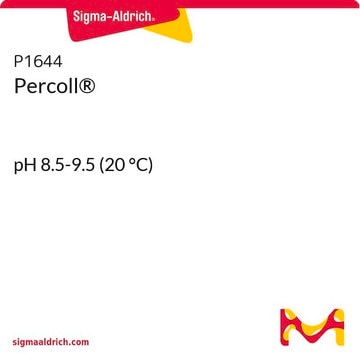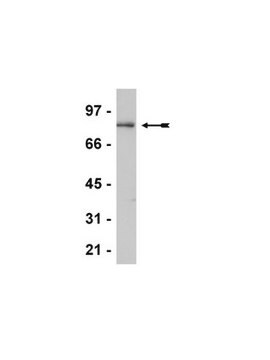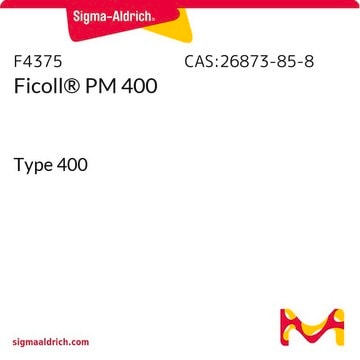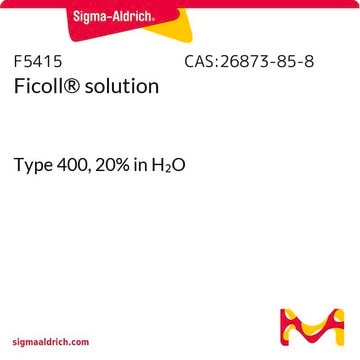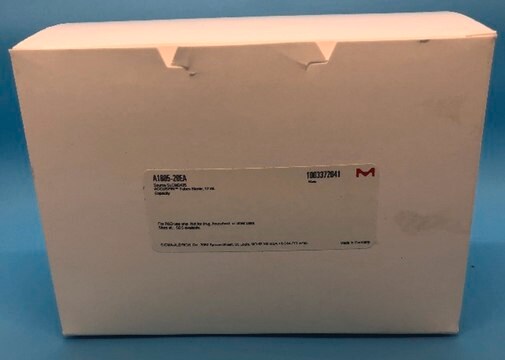This product ships at ambient temperature and is stable for relatively short periods at room temperature. There is a 1 - 2 week allowance for transit time. A storage temperature excursion of 2 days is not expected to impact the quality or performance of this material.
10771
Histopaque®-1077
sterile-filtered, density: 1.077
Select a Size
About This Item
Recommended Products
sterility
sterile-filtered
Quality Level
form
liquid
shelf life
Expiry date on the label.
impurities
endotoxin, tested
density
1.077
application(s)
hematology
histology
storage temp.
2-8°C
General description
Application
- human lymphocyte antigen (HLA) typing
- initial isolation step prior to the enumeration of T, B, and ‘null’ lymphocytes.
- preparation of pure lymphocyte suspensions for cell culture and cytotoxicity assays.
- isolation and purification of peripheral blood mononuclear cells (PBMCs) and bone marrow mononuclear cells (BMMCs)[1]
- isolation of human lymphocytes[2]
- isolation of breast cancer circulating tumor cells (CTCs) from the whole blood[3]
- Histopaque-1077 is used in conjunction with Histopaque-1119 as it facilitates the rapid recovery of viable mononuclear cells and granulocytes from small volumes of whole blood
Features and Benefits
- Optimal recovery of viable cells
- Permits selective separation of blood cell types
- Prevents cell distortion
- Preserves cell viability
- Minimal extraneous cell interference
- Reproducible performance from batch to batch
- Sterile-filtered and endotoxin-tested
- Stable at 2-8°C for at least 2 years when protected from light
Principle
Legal Information
also commonly purchased with this product
recommended
related product
signalword
Danger
hcodes
Hazard Classifications
Resp. Sens. 1 - Skin Sens. 1
Storage Class
12 - Non Combustible Liquids
wgk_germany
WGK 3
Choose from one of the most recent versions:
Already Own This Product?
Find documentation for the products that you have recently purchased in the Document Library.
Customers Also Viewed
Articles
Centrifugation enables the separation of particles by sedimentation. Learn how to separate particles using a centrifuge and how to use Stokes' law to calculate the velocity of sedimentation.
Protocols
This troubleshooting guide addresses the most common sources of error observed when using Histopaque but is not meant to be a comprehensive list.
Ficoll 400® is a non-ionic polymer with high hydrophilicity and water solubility, suitable for various biological applications.
-
Hello, we had a problem with the refrigerator leading the temperature increasing to 44 degrees Celsius for over the 2 days of weekend, so can our Histopaque-1077 stored in this refrigerator can be used anymore?
1 answer-
Helpful?
-
-
What is the percentage of peripheral blood mononuclear cells (PBMCs) recovered from human blood?
1 answer-
Generally, Histopaque recoveries typically range from 50% to 80%. The percentage of recovery varies significantly depending on the total white cell count of the patient. Higher white cell counts typically have the best recovery rates. Yields are also generally higher with fresh blood and lower with older blood.
Helpful?
-
-
Can Histopaque 10771 be utilized to separate tumor cells from monocytes?
1 answer-
Histopaque 10771 is unlikely to be suitable for separating tumor cells from monocytes. It is designed to separate monocytes and lymphocytes from human blood. Unless the density of your specific tumor cells significantly differs from 1.077 g/ml, there is a possibility that tumor cells may be collected within the mononuclear cell band. Alternatives such as Percoll, Percoll Plus, or OptiPrep could be better options.
Helpful?
-
-
What impact does freezing Histopaque or Ficoll solutions have on PBMC purification? Will the freeze/thaw cycle affect product performance in assays, or will it continue to function as expected?
1 answer-
It is recommended to avoid freezing Histopaque or Ficoll Paque solutions. Thawing can be achieved by leaving the bottles at room temperature, followed by gentle inversion to mix the solution after thawing.If the solution is clear, particle-free, and the bottle is intact, the product is suitable for use. However, if the bottle is cracked or broken, it should be replaced.
Helpful?
-
-
If Histopaque-1077 is brought to room temperature, how long can it be left at that temperature before use? Specifically, will leaving it for a few hours cause any issues?
1 answer-
Ficoll Paque has a storage temperature range of 4°C to 30°C for unopened bottles, while opened bottles should be stored at 4°C to 8°C. However, Histopaque can be stored at room temperature for short periods.
Helpful?
-
-
Can histopaque-1077 be used to isolate live tumor cells in suspension from dead cells/cell debris?
1 answer-
Histopaque 10771 is primarily intended for isolating mononuclear cells from human blood and bone marrow. It is also utilized in cell culture to eliminate dying cells from hybridomas. However, the effectiveness of Histopaque 10771 or Histopaque 10831 in purifying live cells from deceased liver cells remains untested. Percoll and OptiPrep are common alternative methods.
Helpful?
-
-
Does Histopaque®-1077 work for mouse blood, or is Ficoll®-Paque Premium 1.084 a better choice?
1 answer-
While Histopaque 10771 can be used, it is important to note that quality control testing for Histopaque 10771 does not include testing with mouse blood. The preferred products for isolating mononuclear cells from rat and mouse blood are Ficoll Paque Premium 1084 (GE17-5446-02) or Histopaque 10831. These products are specifically formulated for rats, mice, and other small mammals for the higher percentage of cell recovery.
Helpful?
-
-
Can Histopaque 10771 be placed in a 37°C water bath to bring it to room temperature after being taken out of the refrigerator?
1 answer-
Histopaque 10771 is normally stored at 2-8°C for long-term storage. However, it can be shipped at ambient temperature, suggesting that it is not easily affected by short-term storage conditions. Therefore, warming it up to 37°C is unlikely to have any detrimental effects on the product.
Helpful?
-
-
Can we use a ratio of blood to separation media of 4:3 with Histopaque-1077? Also, can Histopaque-1077 be used to dilute the blood up to 1:2 before layering with separation media with HBSS buffer, and then wash the cells too.
1 answer-
Histopaque 10771/H8889 and Ficoll Paque solutions are produced with similar reagents. As Histopaque has a slightly lower density range, yields might be slightly lower. Therefore, it is a mixed bag and yields with Histopaque might be slightly lower. When observing a very high white cell count, dilution is recommended. The standard dilution for peripheral blood is generally 1:2. For bone marrow, a 1:2 or 1:4 dilution are more commonly used. The expectation is that cell recovery should be almost the same.
Helpful?
-
-
Are Histopaque 1077 and Ficoll Paque pure products? What is the percentage of polysaccharide or polysucrose in Histopaque 1077 and Ficoll Paque?
1 answer-
Both Histopaque and Ficoll Paque are formulated with a combination of polysucrose 400 and sodium diatrizoate. On average, Histopaque and Ficoll Paque solutions contain approximately 5.7% polysucrose and 9.0% sodium diatrizoate. The final density of these solutions is expected to be around 1.077 g/ml for both products with a typical density variation of +/- 0.001%.
Helpful?
-
Active Filters
Our team of scientists has experience in all areas of research including Life Science, Material Science, Chemical Synthesis, Chromatography, Analytical and many others.
Contact Technical Service


